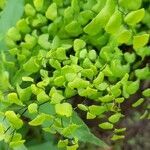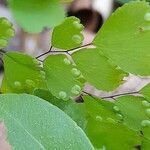Rhizome shortly creeping, branched, up to 2.5 mm in diam., producing slender stolon-like branches up to 50 mm long, variously scaled; scales reddish brown, narrowly lanceolate, up to 5 x 1.2 mm. Fronds crowded, erect or arching, up to 750 mm long. Stipe firm, terete, dark brown, glossy, up to 360 mm long and 1.5 mm in diam., initially sparsely set with scales similar to those on rhizome. Lamina ovate to deltate, up to 400 x 280 mm, up to 5-pinnate. Rachis and lower order axes dark brown and glossy. Pinnae alternate, basal pinna pair largest, ovate to deltate, up to 225 x 115 mm, up to 4-pinnate; petioles up to 34 mm long. Pinnules ovate to elliptic, up to 90 x 55 mm, petioles up to 22 mm long; segments petiolate, ovate to elliptic, up to 42 x 22 mm; ultimate segments articulated to petioles up to 4 mm long, reniform, basal margins straight or broadly cuneate, thinly herbaceous, glabrous, up to 12 x 16 mm, lobed, outer lobe margins denticulate; venation evident, branches end in sinuses between teeth. Sori up to 7 per ultimate segment. Sporangia confined to veins in reniform soral flaps up to 4 x 1 mm.
Rhizome slender, widely creeping, set with appressed, castaneous, lanceolate-acuminate, somewhat ciliate rhizome-scales c. 8 x 0.8 mm. Fronds closely spaced, arching, thinly herbaceous; stipe castaneous, glabrous, up to 250 mm long; lamina broadly ovate-deltate, up to 450 x 330 mm, 3-to 4-pinnate; pinnules very broadly obcuneate to semicircular or shallowly reniform, up to 15 x 20 mm, articulated at apex of filiform petiolules, membranous, glabrous or with yellow powder below, deciduous with age leaving bare petiolules attached to secondary rhachises of old fronds; rhachis and secondary rhachises castaneous, glabrous. Sori borne along outer margin of pinnules; indusial flaps lunate, up to 2.5 mm long.
Terrestrial or epilithic. Rhizome widely creeping. Fronds crowded, erect to arching, 2-4-pinnate, lamina ovate, up to 300 x 250 mm, glabrous; pinnules ovate to elliptic, deciduous, shallowly incised, margins crenulate, veins ending in sinuses between crenations of teeth. Sporangia in oblong to reniform sori borne along acroscopic margins, with green, glabrous indusial flap.
Perennial with widely spreading rhizome. Fronds arching, soft, stipe glabrous, lamina ovate-deltate, 3-or 4-pinnate, pinnules obcuneate to shallowly reniform, articulated at apex of filiform petiolules, veins ending in sinuses between marginal teeth. Sori along outer margins of pinnules, indusial flaps lunate.
Rhizome creeping, set with appressed rhizome scales. Fronds 3-or 4-pinnate. Veins of sterile pinnules ending in sinuses between marginal teeth or crenations of teeth. Ultimate segments articulated, eventually deciduous. Sori lunate.


